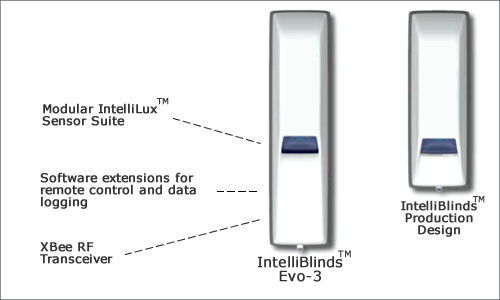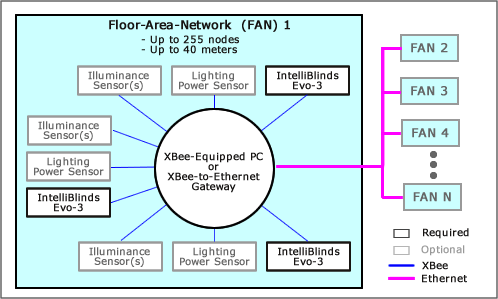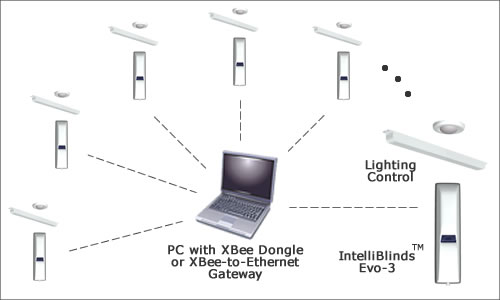Research and Demonstration Program
Overview
The latest IntelliBlinds™ prototype, the Evo-3, provides a super-set of the capabilities of the reference IntelliBlinds™ Model D production design, including hardware and software to enable remote control, performance monitoring, and environmental data collection via a wireless RF link. The original purpose of designing these capabilities into the Evo-3 was to facilitate testing and fine-tuning of the user interface and daylight control algorithms.
However, these capabilities would also enable the Evo-3 to support broader daylighting research, test, and demonstration objectives in occupied buildings. For example, in addition to demonstrating the effectiveness of IntelliBlinds™ itself in real-world conditions, such a program could be aimed at demonstrating the full potential of daylight harvesting in sidelit spaces, or investigating the impact of varying daylight levels on occupant productivity and absenteeism.
Such a program isn't necessary for IntelliBlinds™ commercialization, but could be very useful from a marketing standpoint—particularly if co-sponsored by a utility, university laboratory, or government agency. For that reason, we've included it in our reference commercialization plan (albeit not on the critical path to market entry).
Evo-3 Research Capabilities
The Evo-3 prototype includes research-oriented design features and capabilities that are omitted from the reference production design for cost reasons:
- XBee-compliant RF transceiver and antenna
- Expanded IntelliLux™ sensor configuration (details omitted here due to overlap with in-process patent applications)
- Serial command language to support remote control, performance monitoring, and data logging

RF Network Configurations
The Evo-3 is intended to be used in a star-topology network configuration, with each Evo-3 node connected to a controller/hub via a point-to-point RF link. The controller/hub is also capable of broadcasting messages to all nodes simultaneously.
Evo-3 nodes can include IntelliBlinds™ Evo-3 units, XBee-enabled WorkPlane Illuminance (WPI) sensors, XBee-enabled lighting power monitors, and other devices. Each controller/hub can communicate with 255 Evo-3 nodes at ranges of up to 40 meters. The controller/hub can be an XBee-enabled PC or an XBee-to-ethernet gateway, enabling multiple networks to be managed by a single PC.

This allows a single PC to manage an Evo-3 network of up to hundreds of nodes, spanning hundreds of meters.
Sensor Suite
Due to in-process (but not yet officially pending) patent applications, we can't yet disclose details of the Evo-3 sensor suite on this site. However, in general, the sensors support measurement of the exterior vertical daylight illuminance, several variables related to the interior daylight level, and the relative artificial lighting level.
Some of the sensor outputs can be roughly mapped to accepted photometric quantities. And the relative artificial lighting level can be roughly translated to lighting power consumption in watts, using a non-linear watts-per-lux calibration curve obtained during system installation.
And while the sensors can't take the place of conventional photometric instrumentation, they do have the significant advantage of being completely integrated into the Evo-3 at the top of the window, whereas conventional instruments must be located at eye level or on the workplane. So, data can be collected with Evo-3 in operating buildings with minimal disruption of the occupants' activities. This gives the data a degree of real-world relevance which could be more valuable, for some research purposes, than photometric accuracy.
Command Language
The Evo-3 software includes a command language that allows a remote PC to control and monitor all aspects of the IntelliBlinds™ Model D's operation. The master can read all of the Evo-3 raw sensor outputs and major internal variables, change key operating parameters (e.g. the daylight control set-point or sampling interval), and remotely download new software. The following table lists some of the over 120 available commands:
| Command | Description |
|---|---|
| g_Daylight_Exterior_Alpha_equate_byte | Reads/Sets averaging time-constant for exterior daylight sensing |
| g_Daylight_Exterior_Average_read_byte | Reads average exterior daylight level |
| g_Daylight_Exterior_BrightSun_Threshold_equate_byte | Reads/Sets exterior daylight threshold for declaration of "bright sun" to arbitrary value |
| g_Daylight_Exterior_BrightSun_Threshold_store_byte | Stores current exterior daylight level as "bright sun" threshold |
| g_Daylight_Exterior_Calibrated_Accumulated_Minutes_equate_byte | Reads/Sets exterior daylight Lux*Minutes product |
| g_Daylight_Exterior_Calibrated_equate_byte | Reads/Sets exterior daylight reading calibrated in lux |
| g_Daylight_Exterior_Calibration_Coefficient_equate_byte | Reads/Sets exterior daylight calibration coefficient |
| g_Daylight_Exterior_Current_read_byte | Reads current (non-averaged) exterior daylight level |
| g_Daylight_Exterior_Daytime_Threshold_equate_byte | Reads/Sets exterior daylight threshold for declaration of "daytime" |
| g_Daylight_Exterior_Daytime_Threshold_store_byte | Stores current exterior daylight level as daytime" threshold |
| g_Daylight_Interior_Alpha_equate_byte | Reads/Sets averaging time-constant for interior daylight sensing |
| g_Daylight_Interior_Average_read_byte | Reads average interior daylight level |
| g_Daylight_Interior_Calibrated_Accumulated_Minutes_equate_byte | Reads/Sets interior daylight Lux*Minutes product |
| g_Daylight_Interior_Calibrated_equate_byte | Reads/Sets interior daylight reading calibrated in lux |
| g_Daylight_Interior_Calibration_Coefficient_equate_byte | Reads/Sets interior daylight calibration coefficient |
| g_Daylight_Interior_Current_read_byte | Reads current (non-averaged) interior daylight level |
| g_Daylighting_Adjustment_Counter_equate_byte | Reads/Sets count of daylighting shading adjustments since system reset |
| g_Daylighting_Conditions_Accumulated_Minutes_equate_byte | Reads/Sets count of accumulated minutes over which daylighting conditions were met |
| g_Daylighting_Disable_do_byte | Disables dynamic daylight control |
| g_Daylighting_Enable_do_byte | Enables dynamic daylight control |
| g_Daylighting_Mode_equate_byte | Reads/Sets daylighting mode control bits |
| g_Daylighting_On_Accumulated_Minutes_equate_byte | Reads/Sets count of accumulated minutes over which Dynamic Daylight Control was engaged |
| g_Daylighting_Setpoint_equate_byte | Reads/Sets dynamic daylight control setpoint |
| g_Daylighting_Setpoint_Update_Delay_equate_byte | Reads/Sets delay between manual adjustment and update of setpoint |
| g_Daylighting_Status_equate_byte | Reads/Sets daylighting status bits |
| g_Daylighting_Tolerance_equate_byte | Reads/Sets daylight regulation tolerance |
| g_Daylighting_Tolerance_Factor_equate_byte | Read/Sets daylight regulation tolerance factor |
| g_Daylighting_Tolerance_Minimum_equate_byte | Reads/Sets minimum daylight regulation tolerance |
| g_Daytime_Accumulated_Minutes_equate_byte | Reads/Sets counter of accumulated minutes over which Daytime conditions were met |
| g_Daytime_Duration_read_byte | Reads duration of previous day in minutes |
Potential Program Objectives
The Evo-3 can support a variety of research and demonstration objectives involving dynamic daylighting in sidelit spaces, such as:
- Demonstration of IntelliBlinds™ energy savings under real-world conditions
- Investigation of impact of various daylight control prototocols
- Investigation of impact of different lighting control protocols (e.g. switching-only versus dimming/switching)
- Investigation of occupant-preferred daylight levels versus artificial lighting levels, including impact of wireless remote control for both shading and lighting
- Impact of wireless remote control on frequency of occupant-initiated shading adjustments
- Impact of daylight regulation algorithm parameters (e.g. daylight set-point, update interval, etc.) on energy savings
- Impact of varying daylight levels on occupant productivity and absenteeism
Many of these objectives could be accomplished using an automated shading device other than IntelliBlinds™ Evo-3. However, the Evo-3's wireless networking capability, coupled with its ability to sense and log environmental variables such as the natural and artificial lighting levels, would substantially reduce the need for wiring and additional instrumentation. As previously noted, in addition to reducing cost, this would reduce the obtrusiveness of the test set-up—a crucial advantage for research in occupied buildings.
For example, if a high degree of photometric accuracy in the measurements isn't required, virtually all of the potential demonstration and research objectives mentioned above could be achieved without any equipment whatsoever beyond the Evo-3, daylight-harvesting lighting control, and control PC:

Potential Participants
An Evo-3-based demonstration or research program as described herein would be most effective with participation from the following types of entity:
| Entity | Role | Payoff |
|---|---|---|
| University Laboratory |
|
|
| Building owner/operator |
|
|
| Institutional/commercial tenant | ||
| Lighting controls manufacturer |
|
|
| Daylight Control Technologies |
|
|
| Energy Services Company |
|
|
| Government Agency/Lab |
|
|
Summary of Key Points
- The latest IntelliBlinds™ prototype, the Evo-3, provides a super-set of the capabilities of the Model D reference production design, including hardware and software to enable remote control, performance monitoring, and environmental data collection via a wireless RF link
- While intended primarily to support fine-tuning of the IntelliBlinds™ software, these capabilities would also facilitate daylighting research and demonstrations in occupied buildings
- In addition to Daylight Control Technologies, organizations potentially benefiting from involvement in such a program include university and government laboratories, building owners/operators, institutional/commercial building tenants, manufacturers of lighting controls, and energy services companies

